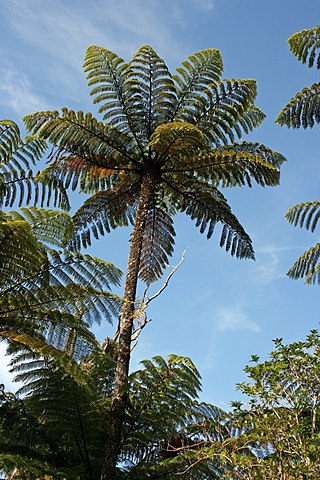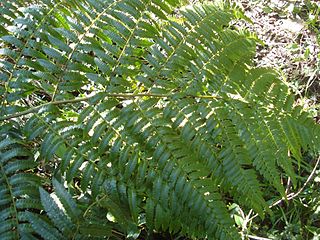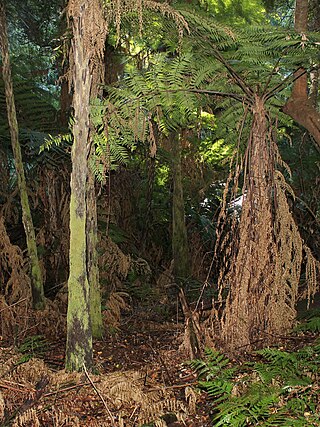
Cyathea is a genus of tree ferns, the type genus of the fern order Cyatheales.

Koncordie Amalie Dietrich was a German naturalist who was best known for her work in Australia from 1863 to 1872, collecting specimens for the Museum Godeffroy in Hamburg.

Cyathea affinis is a variable species of tree fern native to Fiji, Samoa, the Cook Islands, Austral Islands, Tahiti, and the Marquesas Islands. The trunk of this plant is erect and 2–6 m tall. Fronds are bipinnate and 2–3 m in length. The rachis and stipe are pale to brown in colour, or flushed with red towards the pinnule rachis. The stipe is sparsely covered in narrow basal scales, which are pale to dark and have broad fragile edges. Characteristically of this species, the lowest one or two pairs of pinnae may be slightly reduced and occur towards the base of the stipe. Sori are located near the pinnule midvein and are partially or fully covered by indusia, which open towards the pinnule margin.
Gymnosphaera baileyana, synonyms Alsophila baileyana and Cyathea baileyana, also known as the wig tree fern, is a species of tree fern native to northeastern Queensland in Australia, where it grows in wet gullies and forest at an elevation of 850–1200 m. It is a rare species that is seldom found in the wild. The erect trunk is 4–5 m tall, approximately 10 cm in diameter and may be covered in stipe bases in the upper regions. C. baileyana is notable for being able to develop offshoots from the base of the trunk. Fronds are bi- or tripinnate and may be exceptionally long, up to 7 m, though they are usually around 2–3 m. The rachis and stipe are dark to darkish red, scaly and may be warty, but lack spines. Scales on the rachis and stipe are purplish brown to black and have a long hair-like apex. Characteristically of this species, the last pair of pinnae are separated from the others along the rachis and may form a clump around the trunk apex. Sori are circular and occur in one to three rows along the pinnule midvein. They lack indusia.
Cyathea aristata is a species of fern in the family Cyatheaceae, native to Mexico and Colombia. It was first described by Domin in 1930.
Alsophila hermannii, synonym Cyathea christiiCopel., is a species of tree fern endemic to Mindanao in the Philippines, where it grows in forest at an altitude of 900–1800 m. The trunk is erect and may be 5 m tall or more. Fronds are bi- or tripinnate and 2–3 m long. The stipe is covered with some warts and narrow, brown scales. Sori occur near the midvein of fertile pinnules and are covered by thin, fragile indusia.
Cyathea decora is a species of tree fern native to Ecuador and possibly other parts of western South America. Little is known about this species. The name is the source of some taxonomic confusion: as of July 2021, Plants of the World Online regarded "Cyathea decora" as an unplaced name, and it was not listed at all in World Ferns.
Alsophila costalisora, synonym Cyathea costalisora, is a species of tree fern native to western New Guinea, where it grows on the edges of forest and in moist hollows at an altitude of 1900–3225 m. The trunk is erect, up to 4 m tall and may branch near the base. Fronds are bi- or tripinnate and 1–1.5 m long. The stipe is warty, especially where scales have fallen. The scales are pale and have a distinctive dark glossy central region, with a paler dull margin. Sori are round and occur near the fertile pinnule midvein. They are covered by firm, dark indusia that are cup-like in appearance.
Alsophila dryopteroides, synonym Cyathea dryopteroides, is a tree fern native to Puerto Rico, where it grows where it grows in shaded areas and cloud forest at an altitude of 1000–1200 m. The erect trunk may be 1.3 m tall and approximately 5 cm in diameter. Fronds are pinnate and up to 1.6 m long. The rachis is often purplish brown and covered with scales, usually on the underside. The scales range in colour from golden brown to bicoloured. Sori occur along each side of the pinnule midvein and indusia are cup-like.
Cyathea biliranensis is a species of fern in the family Cyatheaceae, native to the Philippines. It was first described by Edwin Copeland in 1955.

Cyathea delgadii is a widespread species of tree fern. It is native to Central America, and much of South America. The specific epithet delgadii refers to Gancho do Generale Delgado, along the road to Caldas Novas, Brazil, where the type material was collected.

Alsophila is a genus of tree ferns in the family Cyatheaceae. It has also been considered to be a section in the subgenus Cyathea of the genus Cyathea.

Hymenophyllum is a genus of ferns in the family Hymenophyllaceae. Its name means "membranous leaf", referring to the very thin translucent tissue of the fronds, which gives rise to the common name filmy fern for this and other thin-leaved ferns. The leaves are generally only one cell thick and lack stomata, making them vulnerable to desiccation. Consequently, they are found only in very humid areas, such as in moist forests and among sheltered rocks. They are small and easy to overlook.

Lastreopsis, known as shieldfern, is a genus of ferns in the family Dryopteridaceae, subfamily Elaphoglossoideae, in the Pteridophyte Phylogeny Group classification of 2016.
Cyathea obtusa is a species of fern in the family Cyatheaceae, native to Trinidad and Tobago, Venezuela, and the Windward Islands. It was first described by Domin in 1929.

Alsophila leichhardtiana, synonym Cyathea leichhardtiana, the prickly tree fern, is a plant in the tree fern family, Cyatheaceae, found in eastern Australia. It is a common species found in moist situations, in and near rainforests. It was named in honour of the explorer and botanical collector Ludwig Leichhardt.

Arthropteris is a small genus of ferns in family Tectariaceae, according to the Pteridophyte Phylogeny Group classification of 2016. It was previously placed in the families Oleandraceae or Davalliaceae. The genus is native to Australia, Europe, Asia and Africa. Around 12 to 21 species are considered part of this genus. The name Arthropteris is from the Greek, meaning "jointed fern", referring to the joint at the base of the petiole.

Pityrogramma, the silverback ferns, or goldback ferns, is a fern genus in the subfamily Pteridoideae of the family Pteridaceae.
Cyathea dichromatolepis is a species of fern in the family Cyatheaceae, native to Southeast Brazil. It was first described by Fée in 1869 as Alsophila dichromatolepis.









